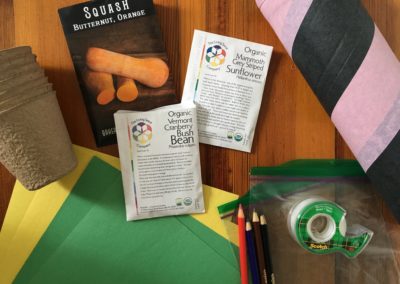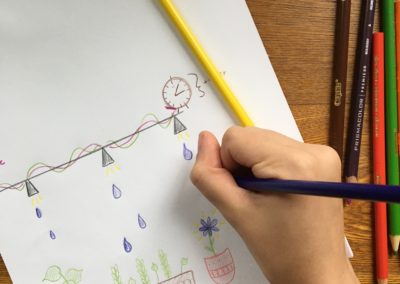Save the Plants
Developed by Rachel Greenberg, PCM Play Intensive 2021
(FOCUS: Grade 1, Language and Literacy, Science, Technology, Arts, Engineering and Mathematics (STEAM))
Living things needs water. Humans need it, animals need it, plants need it! Our plants need water every few days. What happens when we are at home? How will our plants get water? How can we make sure our plants get watered during the weekends and vacations?
STEAM/Literacy connection
First grade students are studying plants in the 4th quarter reading unit. They will be researching various plants, writing opinions about human interactions with plants and creating digital books to present their research.
Combining STEAM thematic curriculum standards with the 4th quarter literacy standards will bring a hands-on learning approach to the otherwise abstract concept of plant propagation and growth. Students will be invested in their plants living, so they can include them in their research.
Materials
- Plants (to be grown in small pots with soil and donated seeds.)
- Pots (suggested: egg cartons, biodegradable pots, planter pots)
- Seeds (to be in place and established before lesson, suggested seeds: beans, peas, summer squash, cucumbers, winter squash)
- Straws Plastic bags
- Various building materials (paper, plastic pieces, etc.)
- Adhesive (glue, tape, etc.)
Set Up
The amount of materials depends on classroom size. The demo classroom has 22 first-grade students. All materials will be organized in bins on a communal table/counter. Students will be able to ‘shop’ in the materials section before and during the construction phase. Set up materials on tables before school. Each table already has adhesive.
Student’s Job
Students will invent a machine to deliver water to the plants over vacation.
Prompt or Challenge:
Every living thing needs water. Humans need it, animals need it, plants need it! Our plants need water every few days. What happens when we are at home? How will our plants get water? How can we make sure our plants get watered during the weekends and vacations?
Design Phase
- You can use any items on your table.
- You can work together (we suggest it!)
- You will have 3 minutes to draw/think on your own.
- Now switch with your table partner! What do you see in your partner’s drawing? What questions do you have? (Suggested sentence stem: I wonder how…)
- Decide which invention and/or parts of your invention you will include in your combined contraption.
- Draw a final mock-up of what your contraption should look like.
- Decide for what materials you think would work.
- Collect the materials.
- As a team, start construction your contraption.
- Test it out! You know you are done when your contraption works!
Further Challenges:
How can we make more contraptions to water all the plants?
What happens when it is not sunny? How could we get plants sunlight?
Teacher’s Job
Standards Alignment
COMMON CORE STATE STANDARDS.MATH.PRACTICE.MP1
Make sense of problems and persevere in solving them.
COMMON CORE STATE STANDARDS.MATH.PRACTICE.MP3
Construct viable arguments and critique the reasoning of others.
COMMON CORE STATE STANDARDS.ELA-LITERACY.SPEAKING & LISTENING.1.1
Participate in collaborative conversations with diverse partners about grade 1 topics and texts with peers and adults in small and larger groups.
COMMON CORE STATE STANDARDS.ELA-LITERACY.SPEAKING & LISTENING.1.5
Add drawings or other visual displays to descriptions when appropriate to clarify ideas, thoughts, and feelings.
NEXT GENERATION SCIENCE STANDARDS: ENGINEERING, TECHNOLOGY, AND APPLICATIONS OF SCIENCE
K-2-ETS1-1. Ask questions, make observations, and gather information about a situation people want to change to define a simple problem that can be solved through the development of a new or improved object or tool.
K-2-ETS1-2. Develop a simple sketch, drawing, or physical model to illustrate how the shape of an object helps it function as needed to solve a given problem.
Connections to previous work?
We are learning all about plants. We already know what plants need to survive and water is one of these things. We also know that we are not here on the weekends but are still responsible for these living things.
Facilitation Strategies
Walk around and ask questions to prompt exploration and communication.
• “What makes you think that?”
• “How could you solve that?”
• “What does your partner think?”
• “Check out ____’s idea. That might help you.”
• “Could you combine your ideas?” “What would that look like?”
Play to Notice
Notice that using a straw with a baggie of water could be a helpful idea.
Notice that working together is better than working alone.
Content Matter to Notice
Think about how plants work together? (Not sure if they will get there on their own, but this can be a wondering during our share time.)
Prior front-loading. Plant book-o-rama where students read all about plants and together the class charts the combined basic understanding of plant structures and needs. Students have already done a plant unit in kindergarten, so this information should be review. First graders are deepening the knowledge of how humans interact with plants.
SEL to Notice
Using sentence stems to talk to each other during work time.
Share the responsibility and not allow just one person to do all the work




0 Comments